英文邮件注意事项
- 格式:docx
- 大小:23.84 KB
- 文档页数:7
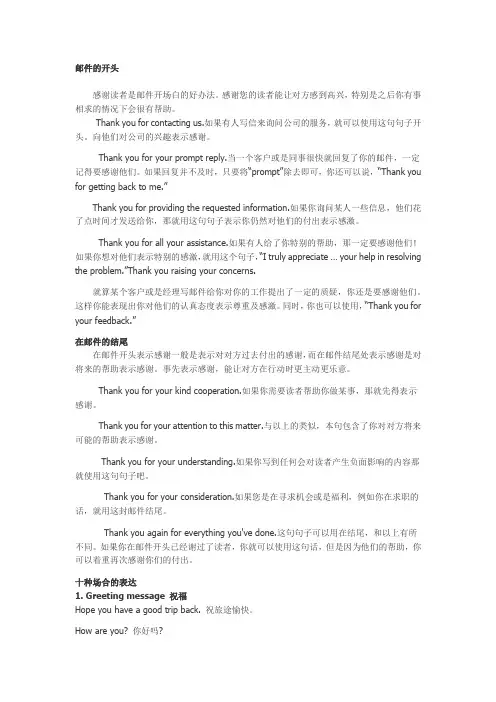
邮件的开头感谢读者是邮件开场白的好办法。
感谢您的读者能让对方感到高兴,特别是之后你有事相求的情况下会很有帮助。
Thank you for contacting us.如果有人写信来询问公司的服务,就可以使用这句句子开头。
向他们对公司的兴趣表示感谢。
Thank you for your prompt reply.当一个客户或是同事很快就回复了你的邮件,一定记得要感谢他们。
如果回复并不及时,只要将“prompt”除去即可,你还可以说,“Thank you for getting back to me.”Thank you for providing the requested information.如果你询问某人一些信息,他们花了点时间才发送给你,那就用这句句子表示你仍然对他们的付出表示感激。
Thank you for all your assistance.如果有人给了你特别的帮助,那一定要感谢他们!如果你想对他们表示特别的感激,就用这个句子,“I truly appreciate … your help in resolving th e problem.”Thank you raising your concerns.就算某个客户或是经理写邮件给你对你的工作提出了一定的质疑,你还是要感谢他们。
这样你能表现出你对他们的认真态度表示尊重及感激。
同时,你也可以使用,“Thank you for your feedback.”在邮件的结尾在邮件开头表示感谢一般是表示对对方过去付出的感谢,而在邮件结尾处表示感谢是对将来的帮助表示感谢。
事先表示感谢,能让对方在行动时更主动更乐意。
Thank you for your kind cooperation.如果你需要读者帮助你做某事,那就先得表示感谢。
Thank you for your attention to this matter.与以上的类似,本句包含了你对对方将来可能的帮助表示感谢。
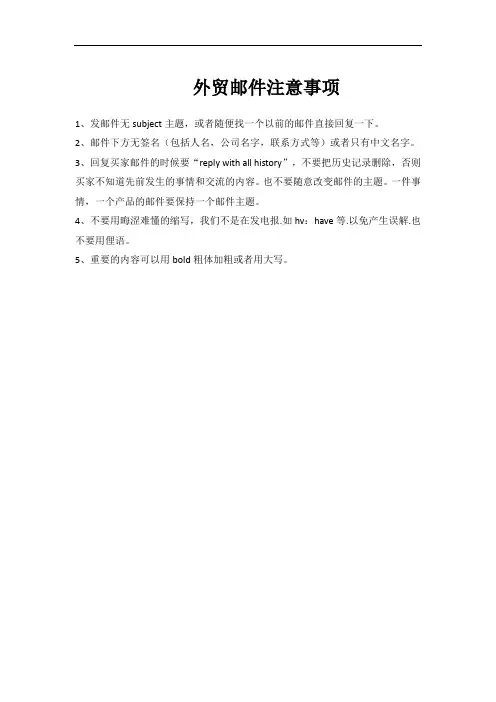
外贸邮件注意事项
1、发邮件无subject主题,或者随便找一个以前的邮件直接回复一下。
2、邮件下方无签名(包括人名,公司名字,联系方式等)或者只有中文名字。
3、回复买家邮件的时候要“reply with all history”,不要把历史记录删除,否则买家不知道先前发生的事情和交流的内容。
也不要随意改变邮件的主题。
一件事情,一个产品的邮件要保持一个邮件主题。
4、不要用晦涩难懂的缩写,我们不是在发电报.如hv:have等.以免产生误解.也不要用俚语。
5、重要的内容可以用bold粗体加粗或者用大写。
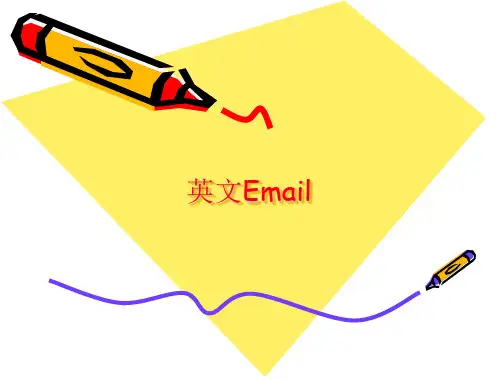
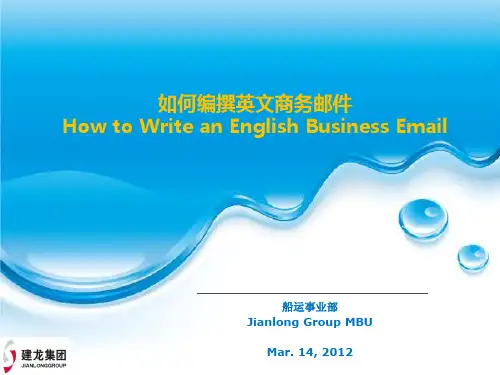
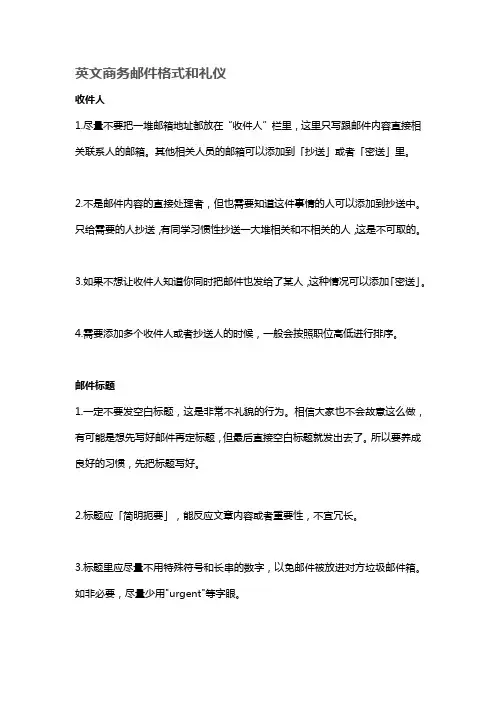
英文商务邮件格式和礼仪收件人1.尽量不要把一堆邮箱地址都放在“收件人”栏里,这里只写跟邮件内容直接相关联系人的邮箱。
其他相关人员的邮箱可以添加到「抄送」或者「密送」里。
2.不是邮件内容的直接处理者,但也需要知道这件事情的人可以添加到抄送中。
只给需要的人抄送,有同学习惯性抄送一大堆相关和不相关的人,这是不可取的。
3.如果不想让收件人知道你同时把邮件也发给了某人,这种情况可以添加「密送」。
4.需要添加多个收件人或者抄送人的时候,一般会按照职位高低进行排序。
邮件标题1.一定不要发空白标题,这是非常不礼貌的行为。
相信大家也不会故意这么做,有可能是想先写好邮件再定标题,但最后直接空白标题就发出去了。
所以要养成良好的习惯,先把标题写好。
2.标题应「简明扼要」,能反应文章内容或者重要性,不宜冗长。
3.标题里应尽量不用特殊符号和长串的数字,以免邮件被放进对方垃圾邮件箱。
如非必要,尽量少用"urgent"等字眼。
4.回复对方邮件的时候,可以根据需要更改标题,不要一长串"RE"。
比如要回复收件人关于一款小黄人设计图的问题,邮件标题就可以简单地描述如下:RE:Art work of minions item附件1.如果有附件,标题写好马上上传附件,养成好习惯,不要等到邮件写完最后再上传,最后很可能会忘记。
相信不少人有过漏传附件的经历,邮件发出去才发现附件没上传。
2.邮件有附件时,应在正文里提醒收件人查收附件。
3.附件个数不宜过多,一般不超过4个。
数量较多的时候可以打包压缩成一个文件。
4.如果附件内容是特殊格式,应告知收件人打开方式,以免影响使用。
5.如果附件过大,最好拆分为多个邮件发送,或者通过网盘分享。
单封邮件附件过大可能发送不成功,或者被拦截。
比如,附件压缩包里是Art work的源文件,需要解压缩后用Illustrator打开,上传附件后可以在邮件中提醒如下:邮件内容1.首先是称呼:第一次联系尽量用「Dear XXX」作为称呼,不知道姓名只知道头衔的情况下,可用「Dear Title」,熟悉了之后也可以用「Hi XXX」或者「Hello XXX 」。
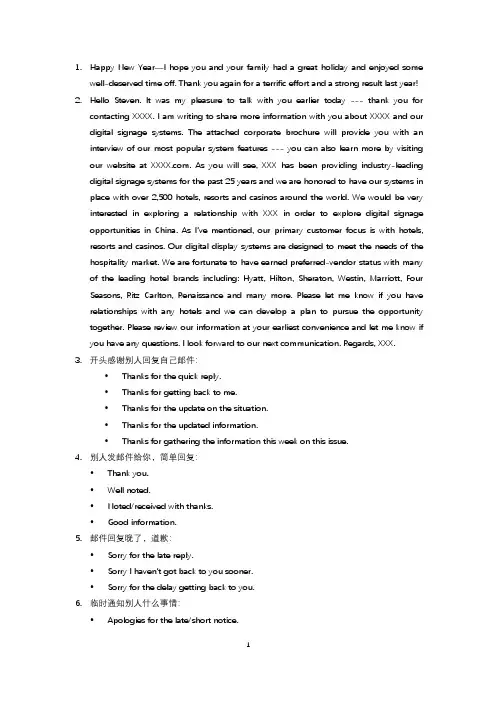
1.Happy New Year—I hope you and your family had a great holiday and enjoyed somewell-deserved time off.Thank you again for a terrific effort and a strong result last year!2.Hello Steven.It was my pleasure to talk with you earlier today---thank you forcontacting XXXX.I am writing to share more information with you about XXXX and our digital signage systems.The attached corporate brochure will provide you with an interview of our most popular system features---you can also learn more by visiting our website at .As you will see,XXX has been providing industry-leading digital signage systems for the past25years and we are honored to have our systems in place with over2,500hotels,resorts and casinos around the world.We would be very interested in exploring a relationship with XXX in order to explore digital signage opportunities in China.As I’ve mentioned,our primary customer focus is with hotels, resorts and casinos.Our digital display systems are designed to meet the needs of the hospitality market.We are fortunate to have earned preferred-vendor status with many of the leading hotel brands including:Hyatt,Hilton,Sheraton,Westin,Marriott,Four Seasons,Ritz Carlton,Renaissance and many more.Please let me know if you have relationships with any hotels and we can develop a plan to pursue the opportunity together.Please review our information at your earliest convenience and let me know if you have any questions.I look forward to our next communication.Regards,XXX.3.开头感谢别人回复自己邮件:•Thanks for the quick reply.•Thanks for getting back to me.•Thanks for the update on the situation.•Thanks for the updated information.•Thanks for gathering the information this week on this issue.4.别人发邮件给你,简单回复:•Thank you.•Well noted.•Noted/received with thanks.•Good information.5.邮件回复晚了,道歉:•Sorry for the late reply.•Sorry l haven’t got back to you sooner.•Sorry for the delay getting back to you.6.临时通知别人什么事情:•Apologies for the late/short notice.7.如果是上一封邮件没写清楚导致收件人误解了:•I apologize if this was not made clear.8.提前给别人预警如果自己的措辞过于强硬:•I apologize if this may make you feel uncomfortable/bad.•I apologize if this may sound a little harsh.9.收尾•Please let me know what you think.•Please let me know your thoughts.•Let me know if you have any questions or concerns.•Please let me know if there are questions.•Looking forward to your input/insight.•That’s my idea,what’s your idea?•Please review the lengthy e-mail and provide feedback on how we can proceed.•I’ll let you know more tomorrow.•Please call me if you like.10.称呼普通工作邮件,直接称呼名字即可,如Hi Steven,不需要用Mr.,甚至写给总裁的邮件,也是直接说Hi Bill,不需要Hi President Bill;学术场合才需要加抬头,比如Prof.Johnson;称呼一般不加Dear,只有公司HR群发邮件才说Dear all,发给个人的,一般就Hi Steven;群发邮件称呼,只有群发给整个公司的邮件,比如公司新闻之类的才用Dear all,Hi all,其它时候用,•Team,(最常用)•Gents,(如果全部是男的)11.抄送别人•I have put John on copy.•You can copy Steven going forward.12.把某个人删除,用remove•Removed Mike rom this e-mail.13.回复邮件,get back比reply常用•I will get back to you tomorrow.14.附件,一般直接用动词attached,enclosed。
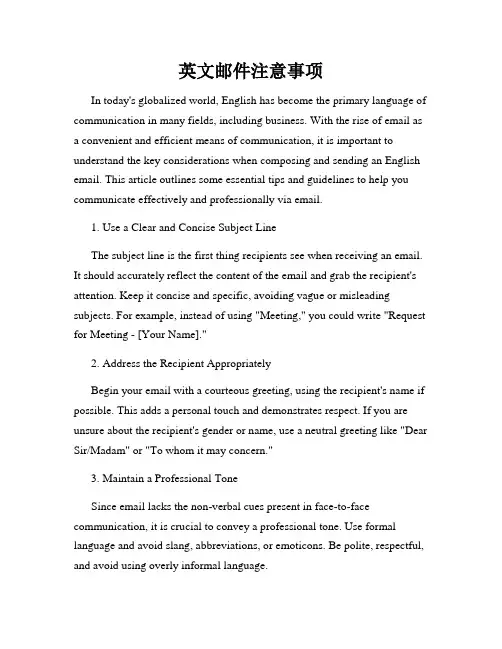
英文邮件注意事项In today's globalized world, English has become the primary language of communication in many fields, including business. With the rise of email as a convenient and efficient means of communication, it is important to understand the key considerations when composing and sending an English email. This article outlines some essential tips and guidelines to help you communicate effectively and professionally via email.1. Use a Clear and Concise Subject LineThe subject line is the first thing recipients see when receiving an email. It should accurately reflect the content of the email and grab the recipient's attention. Keep it concise and specific, avoiding vague or misleading subjects. For example, instead of using "Meeting," you could write "Request for Meeting - [Your Name]."2. Address the Recipient AppropriatelyBegin your email with a courteous greeting, using the recipient's name if possible. This adds a personal touch and demonstrates respect. If you are unsure about the recipient's gender or name, use a neutral greeting like "Dear Sir/Madam" or "To whom it may concern."3. Maintain a Professional ToneSince email lacks the non-verbal cues present in face-to-face communication, it is crucial to convey a professional tone. Use formal language and avoid slang, abbreviations, or emoticons. Be polite, respectful, and avoid using overly informal language.4. Keep the Email Concise and to the PointTime is valuable, so ensure your email is clear and concise. Use short paragraphs and bullet points to break down information and make it easier to read. Use plain language, avoiding unnecessary technical jargon or complex sentences. Get straight to the point and avoid rambling or going off-topic.5. Use Proper Grammar and SpellingPoor grammar and spelling mistakes can reflect negatively on your professionalism and credibility. Always proofread your email for any grammatical errors or typos before sending it. Consider using grammar and spelling-check tools to ensure accuracy.6. Be Mindful of Cultural DifferencesWhen communicating with individuals from different cultural backgrounds, it is important to be aware of potential differences in language usage, etiquette, and sensitivities. Be respectful and considerate of diverse perspectives and customs, ensuring your email is culturally appropriate.7. Reply Promptly and Follow-UpEmail is intended for quick communication, so aim to respond promptly to any incoming emails. Avoid unnecessary delays in replying, as it can create the impression of disinterest or unprofessionalism. If you need more time to provide a comprehensive response, acknowledge the email promptly, notifying the recipient of the expected delay.8. Attachments and FormattingWhen attaching files to your email, ensure they are relevant and necessary. Compress large files if possible to avoid overwhelming the recipient's inbox. Additionally, be considerate of different operating systems or software versions regarding compatibility. Format your email properly, using standard fonts and appropriate formatting (e.g., bold or italics) to highlight key points.9. Review before SendingBefore hitting the send button, double-check the recipients, subject line, content, and attachments of your email. Verify that you have not missed any crucial information or made any mistakes. Once an email is sent, it can be challenging to recall or correct.10. Use a Professional Email SignatureAn email signature provides additional information about you and your contact details. It enhances your professional image and makes it easier for recipients to reach you. Include your full name, job title, company name, and relevant contact information in a clean and standardized format.By following these essential tips and guidelines, you can ensure that your English emails are effective, professional, and well-received. Investing time and effort into crafting quality emails will enhance your communication skills and help you build successful professional relationships in an increasingly globalized world.。
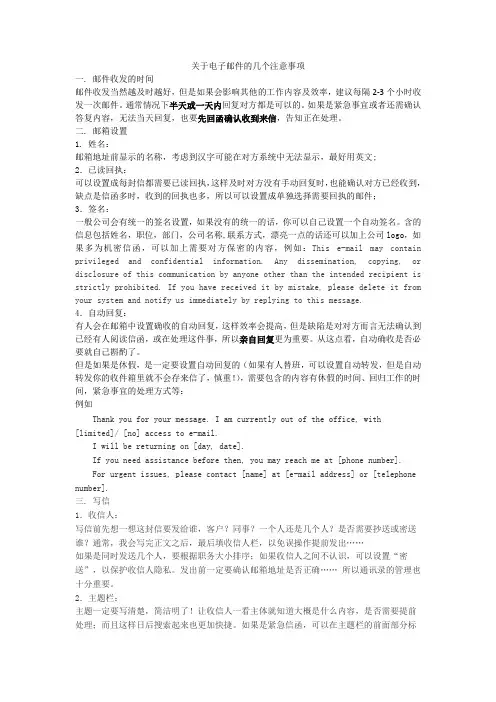
关于电子邮件的几个注意事项一.邮件收发的时间邮件收发当然越及时越好,但是如果会影响其他的工作内容及效率,建议每隔2-3个小时收发一次邮件。
通常情况下半天或一天内回复对方都是可以的。
如果是紧急事宜或者还需确认答复内容,无法当天回复,也要先回函确认收到来信,告知正在处理。
二. 邮箱设置1. 姓名:邮箱地址前显示的名称,考虑到汉字可能在对方系统中无法显示,最好用英文;2.已读回执:可以设置成每封信都需要已读回执,这样及时对方没有手动回复时,也能确认对方已经收到,缺点是信函多时,收到的回执也多,所以可以设置成单独选择需要回执的邮件;3.签名:一般公司会有统一的签名设置,如果没有的统一的话,你可以自己设置一个自动签名。
含的信息包括姓名,职位,部门,公司名称,联系方式,漂亮一点的话还可以加上公司logo,如果多为机密信函,可以加上需要对方保密的内容,例如:This e-mail may contain privileged and confidential information. Any dissemination, copying, or disclosure of this communication by anyone other than the intended recipient is strictly prohibited. If you have received it by mistake, please delete it from your system and notify us immediately by replying to this message.4.自动回复:有人会在邮箱中设置确收的自动回复,这样效率会提高,但是缺陷是对对方而言无法确认到已经有人阅读信函,或在处理这件事,所以亲自回复更为重要。
从这点看,自动确收是否必要就自己斟酌了。
但是如果是休假,是一定要设置自动回复的(如果有人替班,可以设置自动转发,但是自动转发你的收件箱里就不会存来信了,慎重!),需要包含的内容有休假的时间、回归工作的时间,紧急事宜的处理方式等:例如Thank you for your message. I am currently out of the office, with [limited]/ [no] access to e-mail.I will be returning on [day, date].If you need assistance before then, you may reach me at [phone number].For urgent issues, please contact [name] at [e-mail address] or [telephone number].三. 写信1.收信人:写信前先想一想这封信要发给谁,客户?同事?一个人还是几个人?是否需要抄送或密送谁?通常,我会写完正文之后,最后填收信人栏,以免误操作提前发出……如果是同时发送几个人,要根据职务大小排序;如果收信人之间不认识,可以设置“密送”,以保护收信人隐私。
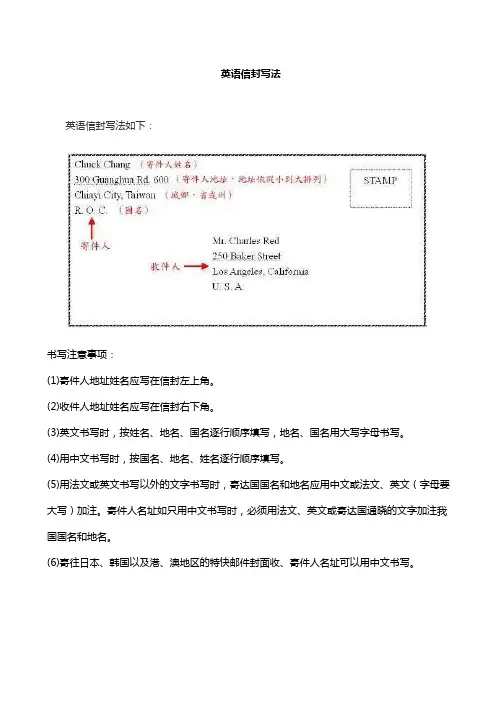
英语信封写法
英语信封写法如下:
书写注意事项:
(1)寄件人地址姓名应写在信封左上角。
(2)收件人地址姓名应写在信封右下角。
(3)英文书写时,按姓名、地名、国名逐行顺序填写,地名、国名用大写字母书写。
(4)用中文书写时,按国名、地名、姓名逐行顺序填写。
(5)用法文或英文书写以外的文字书写时,寄达国国名和地名应用中文或法文、英文(字母要大写)加注。
寄件人名址如只用中文书写时,必须用法文、英文或寄达国通晓的文字加注我国国名和地名。
(6)寄往日本、韩国以及港、澳地区的特快邮件封面收、寄件人名址可以用中文书写。
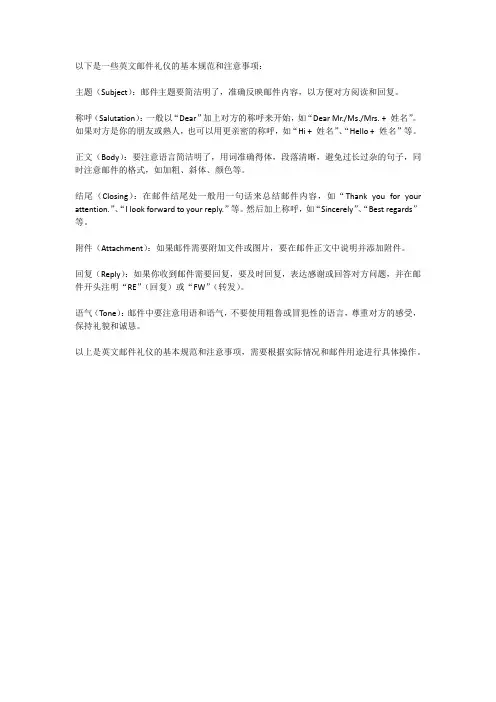
以下是一些英文邮件礼仪的基本规范和注意事项:
主题(Subject):邮件主题要简洁明了,准确反映邮件内容,以方便对方阅读和回复。
称呼(Salutation):一般以“Dear”加上对方的称呼来开始,如“Dear Mr./Ms./Mrs. + 姓名”。
如果对方是你的朋友或熟人,也可以用更亲密的称呼,如“Hi + 姓名”、“Hello + 姓名”等。
正文(Body):要注意语言简洁明了,用词准确得体,段落清晰,避免过长过杂的句子,同时注意邮件的格式,如加粗、斜体、颜色等。
结尾(Closing):在邮件结尾处一般用一句话来总结邮件内容,如“Thank you for your attention.”、“I look forward to your reply.”等。
然后加上称呼,如“Sincerely”、“Best regards”等。
附件(Attachment):如果邮件需要附加文件或图片,要在邮件正文中说明并添加附件。
回复(Reply):如果你收到邮件需要回复,要及时回复,表达感谢或回答对方问题,并在邮件开头注明“RE”(回复)或“FW”(转发)。
语气(Tone):邮件中要注意用语和语气,不要使用粗鲁或冒犯性的语言,尊重对方的感受,保持礼貌和诚恳。
以上是英文邮件礼仪的基本规范和注意事项,需要根据实际情况和邮件用途进行具体操作。
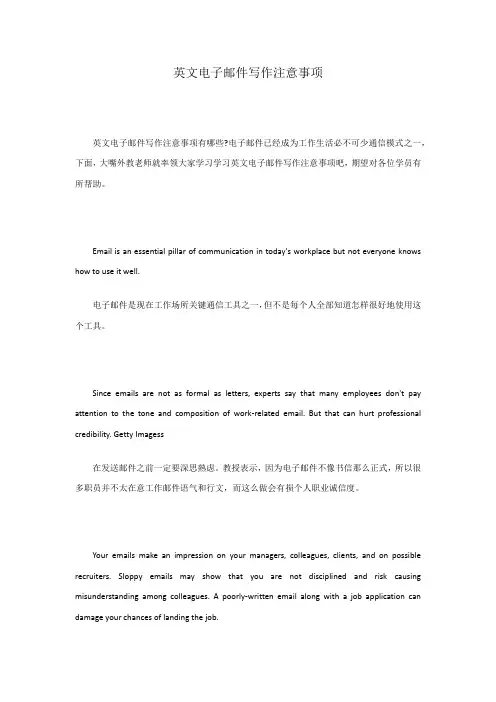
英文电子邮件写作注意事项英文电子邮件写作注意事项有哪些?电子邮件已经成为工作生活必不可少通信模式之一,下面,大嘴外教老师就率领大家学习学习英文电子邮件写作注意事项吧,期望对各位学员有所帮助。
Email is an essential pillar of communication in today's workplace but not everyone knows how to use it well.电子邮件是现在工作场所关键通信工具之一,但不是每个人全部知道怎样很好地使用这个工具。
Since emails are not as formal as letters, experts say that many employees don't pay attention to the tone and composition of work-related email. But that can hurt professional credibility. Getty Imagess在发送邮件之前一定要深思熟虑。
教授表示,因为电子邮件不像书信那么正式,所以很多职员并不太在意工作邮件语气和行文,而这么做会有损个人职业诚信度。
Your emails make an impression on your managers, colleagues, clients, and on possible recruiters. Sloppy emails may show that you are not disciplined and risk causing misunderstanding among colleagues. A poorly-written email along with a job application can damage your chances of landing the job.你写邮件会给你经理、同事、用户和可能招聘人员留下印象。
英文邮件注意事项(3)英文邮件注意事项邮件的主题要明确,如果是紧急邮件的话也要一并说明。
不要写“我有一个问题”,而要写成“我的假日计划;非紧急”。
At the same time, don't make the subject line too long or detailed.同时,主题不宜过长或过于详细。
Also, don't start discussing a new topic under the same subject line. This also makes it difficult to identify mails about specific queries. It's best to send separate emails for separate topics.另外,不要在同一封邮件中讨论主题之外的其他新话题。
这也会使根据某一特定问题查找邮件变得困难。
最好通过发送单独的邮件来讨论不同的话题。
4. Get the name right: Email recipients can get angry if the body of your email has the wrong spelling of their name or, even worse, if you address the person as 'Mr.' when it should really be 'Ms.' Always double-check spellings and titles before sending your email. If you are not sure whether the recipient is male or female, either use the person's first name or the full name.4. 写对对方的称谓:如果你在邮件的正文中把收件人的姓名拼写错误,或者更糟糕地把一位女士称为“先生”,那么很可能会惹恼对方。
商务英语邮件5C原则
其次是Concise(简明)原则。
商务英语邮件应该用最少的词语传达
最多的信息。
为了做到这一点,邮件应该删除所有不必要的细节和重复的
内容。
句子应该精炼有力,没有冗余的修饰语或副词。
段落应该简洁明了,每个段落只传达一个主要观点。
此外,邮件应该避免使用复杂的句子结构
或艰深的词汇,而应该使用简单易懂的语言。
第三个原则是Courteous(礼貌)原则。
一封好的商务英语邮件应该
在语气上表现出对读者的尊重和关注。
邮件应该以礼貌的语气开头,并使
用适当的称呼。
邮件的语气应该友好和善意,避免使用侮辱或冒犯性的语言。
除此之外,邮件还应该感谢读者的时间和关注,以及表达希望能继续
合作的愿望。
总之,礼貌的语气能够增强邮件的亲和力,建立良好的商业
关系。
第四个原则是Correct(正确)原则。
商务英语邮件应该准确无误地
传达信息,避免语法错误、拼写错误和标点符号错误。
为了保证邮件的正
确性,写信人应该仔细检查邮件中的每个单词和句子,确保使用正确的语
法和拼写。
此外,邮件还应遵循邮件写作的规范,如适当使用大写字母、
标点符号和缩写。
英文求职信写作的注意事项
写英文求职信时,有一些注意事项需要特别留意:
1. 格式要规范:求职信应包括信头、称呼、开头、主体和结尾部分,每部分均需清晰明了,格式要规范。
2. 内容简明扼要:避免冗长累赘的句子,简明扼要地表达个人的求职意向、经历和能力。
3. 语言要得体:使用正式的词汇和敬语,避免使用口语化或俚语表达。
4. 重点突出个人优势:突出展示个人和该岗位的匹配度及优势。
5. 检查拼写和语法:务必检查拼写和语法错误,确保信函无错别字和语病。
6. 个性化定制:根据不同的公司和职位要求,量身定制每份求职信,突出与这个职位相关的经验和技能。
在编写求职信时,还应该特别注意到对应职位及公司的研究,确保求职信能够突出个人优势、强调适应性,并展示对公司的兴趣和了解。
一、主题主题(Subject)框的内容应简明地概括信的内容,短的可以是一个单词,如greetings;长的可以是一个名词性短语,也可以是完整句,但长度一般不超过35个字母。
YES:Supplier trainingNO:professional trainees from sister company should abide by rule of local company(太长)主题框的内容切忌含糊不清。
NO:像News about the meeting 这样的表达,YES:应改为Tomorrow's meeting canceled。
一般来说,只要将位于句首的单词和专有名词的首字母大写即可。
另外一种较为正规的格式可将除了少于5个字母的介词、连接词或冠词之外的每一个单词的首字母大写。
YES:New E-mail Address Notification;Detailed calculationNO:detailed calculation视信的内容是否重要,还可以开头加上URGENT或者FYI(For Your Information,供参考),如:URGENT:Submit your report today!二、称呼1、E-mail一般使用非正式的文体,因此正文(Body)前的称呼(Salutation)通常无须使用诸如Dear Mr. John之类的表达。
在同辈的亲朋好友或同事间可以直呼其名,但对长辈或上级最好使用头衔加上姓。
YES:Tommy,或者Mr. Smith。
2、称呼和正文之间,段落之间,正文和信尾客套话之间一般空一行,开头无须空格。
如:Jimmy,I received your memo and will discuss it with Eric on Wednesday.Best,David3、人家的名字千万不要错,老一辈的看到名字错就干脆撵去垃圾桶. 同样, 头衔都不要错. 头衔或学位,任择其一吧.以下是一样的: Howard E. Wyatt, Dr. Howard E. Hyatt4、多过一个男人,用Messrs,就是Misters的意思,不过不要跟名字,跟姓就行啦.YES: Messrs. Smith, Wyatt, and Fury 。
英语发邮件作文咋写好写一封英文邮件需要注意一些关键点,让我来帮你分解一下。
### 1. 邮件格式。
一个标准的邮件格式包括以下几个部分:Subject(主题)。
Salutation(称呼)。
Introduction(介绍)。
Body(正文)。
Closing(结尾)。
Signature(签名)。
### 2. 主题(Subject)。
主题应该简洁明了地概括你的邮件内容。
比如,如果你要询问关于某个产品的信息,主题可以是 "Inquiry about Product Information"。
### 3. 称呼(Salutation)。
根据你写信对象的关系和熟悉程度,选择适当的称呼,比如"Dear Mr./Ms. [Last Name]" 或者 "Hello [First Name]"。
### 4. 介绍(Introduction)。
在介绍部分,你可以简单说明你写这封邮件的目的,以及你与收件人之间的关系(如果有必要)。
### 5. 正文(Body)。
正文是你表达主要内容的部分。
确保清晰明了地陈述你的问题、建议或请求,并提供任何必要的背景信息或支持材料。
### 6. 结尾(Closing)。
在结尾部分,可以表达感谢之情,并且提供进一步行动的建议,比如期待对方的回复或者提供联系方式。
### 7. 签名(Signature)。
在签名处,写上你的名字以及任何必要的联系信息,比如电子邮件地址或电话号码。
### 示例:Subject: Inquiry about Product Information。
Dear Mr. Smith,。
I hope this email finds you well. My name is [Your Name] and I am writing to inquire about the product informationfor [Product Name]. 。
Schedule 目录•I. Confirmation of Email's Aim 邮件目的确认•II. Format of Email 英文邮件格式•III. Tips & Principles 原则和注意事项•IV. Phrases & Sentences Generally Used in Emails 邮件常用语句2•I. Confirmation of Email's Aim•I.邮件目的确认3I. Aim 目的•To express your meaning and business points clearly and without confusion or unnecessary amplification.•清楚的表达你的意思和商务内容,不使人误解,也无夸大•RECEIVERS接收者UDERSTAND THE 理解邮件内容!!CONTENT! 邮件内容4•II. Format of Email•II.邮件格式5•传统的缩头式(the conventional indented form)Dear Sir,I am writing to ...Tks for your ...•现代的齐头式(the modern blocked form) Dear Sir,I am writing to ...Tks for your ...6•Title 题目•Salution (Dear Sir...) 开头称呼语•Message/Body of Email 邮件内容•Complimentary Close 结尾敬语•Writer’s Signature and Designation签名•Enclosure/Attachment 附件7II. Format of Email -ExampleII.邮件格式——例子•Dear Sirs,•It's my honor to know your esteemed company through the internet.We are very interested in your product. We have the intention to purchase your product. Could you pls send your product catalogue by email attachment for us to know the detailed information?•Awaiting for your early reply.•Best regards.•signature8II. Format of Email -PracticeII.邮件格式——练习•Write a complete email that you send to a customer to explain the reason of the bad workmanship.•写一封邮件,内容是向客户解释手工不好的原因。
英文电子邮件写作注意事项英文电子邮件写作注意事项有哪些?电子邮件已经成为工作生活必不可少的通信模式之一,下面,大嘴外教老师就带领大家学习学习英文电子邮件写作的注意事项吧,希望对各位学员有所帮助。
Email is an essential pillar of communication in today's workplace but not everyone knows how to use it well.电子邮件是如今工作场所重要的通信工具之一,但不是每个人都知道如何很好地使用这个工具。
Since emails are not as formal as letters, experts say that many employees don't pay attention to the tone and composition of work-related email. But that can hurt professional credibility. Getty Imagess在发送邮件之前一定要深思熟虑。
专家表示,由于电子邮件不像书信那么正式,因此很多员工并不太在意工作邮件的语气和行文,而这么做会有损个人的职业诚信度。
Your emails make an impression on your managers, colleagues, clients, and on possible recruiters. Sloppy emails may show that you are not disciplined and risk causing misunderstanding among colleagues. A poorly-written email along with a job application can damage your chances of landing the job.你写的邮件会给你的经理、同事、客户和可能的招聘人员留下印象。
漫不经心的邮件可能会让人觉得你的纪律性不强,而且还可能会引起同事们的误会。
找工作时,一封写得很糟糕的邮件会降低你得到工作的可能性。
So, next time you write an email, here are some rules of thumb to keep in mind:因此,当你下一次写邮件的时候,要牢记以下几条“经验法则”:1. Writing style: 'Most youngsters tend to bring the informality of SMS into emails,' says Venkataramana B., chief people officer of the India unit of retail firm Landmark Group. That's a no-no for work emails.1. 写作风格:国际零售巨头蓝玛克集团(Landmark Group)印度公司的人力资源主管温卡塔拉马纳(Venkataramana B.)表示,“大多数年轻人往往会把手机短信中的一些非正式用语用到电子邮件当中。
”这可是工作邮件的大忌。
Follow the rules of grammar and punctuation when composing your email. Avoid slang, acronyms and short forms like 'u' instead of 'you'.在写工作邮件的时候,要遵循语法和拼写的规则,避免使用俚语、首字母缩写或者用字母“u”替代“you”等简写形式。
Don't send emails without a spell check. Avoid exclamation marks, as that may seem immature. Avoid writing in capital letters, since in writing this can be interpreted as the equivalent of shouting.在发送邮件之前要认真检查是否存在拼写错误。
避免使用很多的感叹号,因为那样看上去可能会显得不成熟。
不要用大写字母来写邮件,因为这样容易让对方感觉你像是在吼叫。
(Ideally keep emoticons like ':)' out of official emails. 'There are other avenues like Facebook and Twitter for these things,' says Prashant Deo Singh, head of human resources at Panasonic India Pvt.(在正式的邮件中最好不要使用“:)”等表情符号。
松下电器(Panasonic)印度有限公司人力资源主管普拉山特•迪奥•辛格(Prashant Deo Singh)表示,“这些符号可以用在‘脸谱’(Facebook)和‘推特’(Twitter)当中。
”You can always use your personal email for casual messages, says Runa Maitra, director of human resources at OSC Export Services Pvt., a provider of information technology and management services.信息技术和管理服务公司OSC Export Services Pvt的人力资源主管露娜•梅特拉(Runa Maitra)说,一些非正式的信息可以通过私人邮件来传递。
2. Composition: Given the flood of email we get daily, it's best to keep your emails short and to-the-point. Don't write 'sentences that tend to be never-ending' says Mr. Venkataramana. If you have to make a number of points, use bullets to cover all your points briefly.2. 行文方式:由于我们每天都会收到大量的邮件,所有要尽量让你的邮件篇幅短小、重点突出。
温卡塔拉马纳说,不要写那些“看上去永远不会结尾的句子”。
如果你必须要在邮件中包含多个要点,可以使用着重号把所有的要点简明扼要地标注出来。
If you are replying to a thread of email, consider deleting the older text in the body of your email, or summarizing it in a few lines.如果你正在回复一封往来多次的邮件,就要考虑删去正文中旧有的部分,或者用简短的几句话将其归纳一下。
It's a good idea to add a signature at the end of your email, which includes your phone number and other contact details. This would be particularly useful for emails sent to clients or recruiters, or other people outside your organization.在邮件末尾加上自己的签名是个不错的主意,其中可以写上你的电话号码和其他的联系方式。
这一点在写给客户、招聘人员以及其他外部人员的邮件中尤其重要。
3. Subject line: The lack of a subject line or a vague subject like 'Hello' or 'I have a question' can be annoying to busy people. They also make it harder for the receiver to search for your email in their inbox.3. 主题:缺少主题或者像“你好”或“我有一个问题”等模糊不清的主题会让忙碌的收件人觉得厌烦。
而且,这也会让收件人在收件箱里查找你的邮件变得更困难。
Be specific in your subject line and mention if the matter is urgent. Instead of saying 'I have a question', say 'My holiday plans; not urgent'.邮件的主题要明确,如果是紧急邮件的话也要一并说明。
不要写“我有一个问题”,而要写成“我的假日计划;非紧急”。
At the same time, don't make the subject line too long or detailed.同时,主题不宜过长或过于详细。
Also, don't start discussing a new topic under the same subject line. This also makes it difficult to identify mails about specific queries. It's best to send separate emails for separate topics.另外,不要在同一封邮件中讨论主题之外的其他新话题。
这也会使根据某一特定问题查找邮件变得困难。
最好通过发送单独的邮件来讨论不同的话题。
4. Get the name right: Email recipients can get angry if the body of your email has the wrong spelling of their name or, even worse, if you address the person as 'Mr.' when it should really be 'Ms.' Always double-check spellings and titles before sending your email. If you are not sure whether the recipient is male or female, either use the person's first name or the full name.4. 写对对方的称谓:如果你在邮件的正文中把收件人的姓名拼写错误,或者更糟糕地把一位女士称为“先生”,那么很可能会惹恼对方。